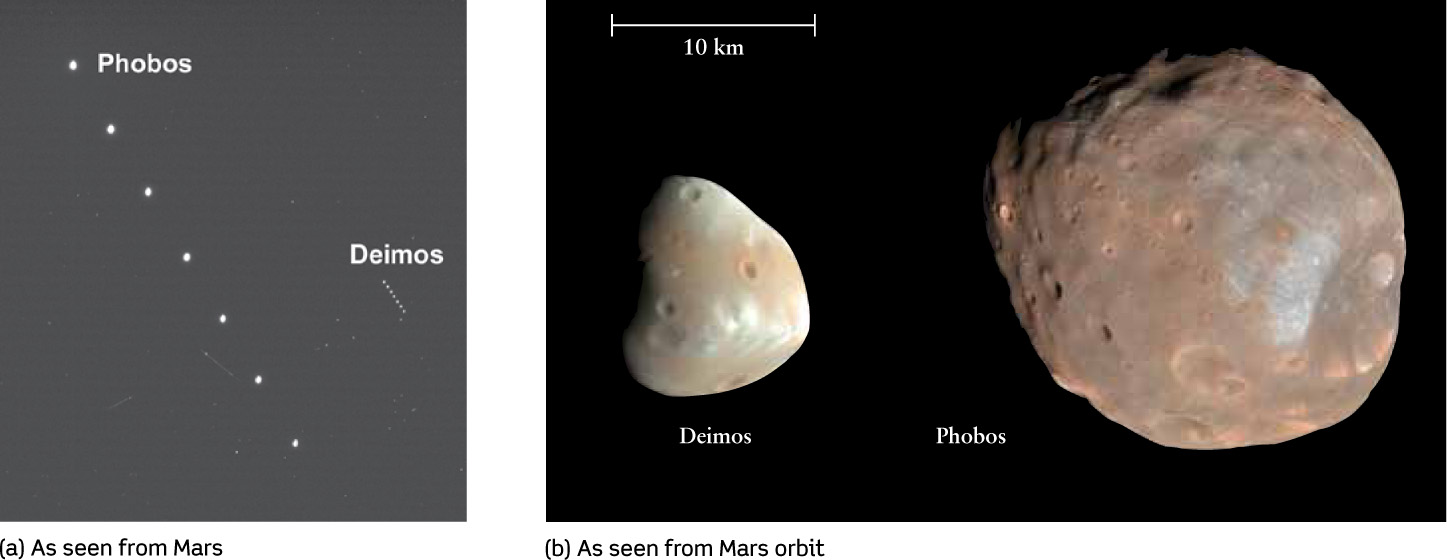11-9 The two Martian moons resemble asteroids
Two moons move around Mars in orbits close to the planet’s surface. These satellites are so tiny that they were not discovered until the favorable opposition of 1877. While Schiaparelli was seeing canals, the American astronomer Asaph Hall spotted the two moons, which orbit almost directly above its equator. He named them Phobos (“fear”) and Deimos (“panic”), after the mythical horses that drew the chariot of the Greek god of war.
The Orbits of Phobos and Deimos
As seen from Mars, Deimos rises in the east but Phobos rises in the west
Phobos is the inner and larger of the Martian moons. It circles Mars in just 7 hours and 39 minutes at an average distance of only 9378 km (5828 mi) from the center of Mars. (Recall that our Moon orbits at an average distance of 384,400 km from Earth’s center.) This orbital period is much shorter than the Martian day; hence, Phobos rises in the west and gallops across the sky in only 5½ hours, as viewed by an observer near the Martian equator. During this time, Phobos appears several times brighter in the Martian sky than Venus does from Earth.
Deimos, which is farther from Mars and somewhat smaller than Phobos, appears about as bright from Mars as Venus does from Earth. Deimos orbits at an average distance of 23,460 km (14,580 mi) from the center of Mars, slightly beyond the right distance for a synchronous orbit—an orbit in which a satellite seems to hover above a single location on the planet’s equator. As seen from the Martian surface, Deimos rises in the east and takes about 3 full days to creep slowly from one horizon to the other. (Figure 11-43a).

The Moons of Mars (a) The Spirit rover recorded seven images of the Martian night sky at 15-minute intervals to produce this composite view of the motions of Deimos and Phobos. (b) Two Mars Reconnaissance Orbiter images have been combined to show Deimos and Phobos and their heavily cratered surfaces to the same scale. The gravity on these moons is only about 1/1000 of Earth’s, and not strong enough to shape them into spheres.
Images from spacecraft in Mars’s orbit reveal Phobos and Deimos to be jagged and heavily cratered (Figure 11-43b). Both moons are somewhat elongated from a spherical shape: Phobos is approximately 28 by 23 by 20 km in size, while Deimos is slightly smaller, roughly 16 by 12 by 10 km. Phobos and Deimos are both in synchronous rotation: The tidal forces that Mars exerts on these elongated moons cause them to always keep the same sides toward Mars, just as Earth’s tidal forces ensure that the same side of the Moon always faces us (see Section 4-8).
We saw in Section 10-5 that the Moon raises a tidal bulge on Earth. Because Earth rotates on its axis more rapidly than the Moon orbits Earth, this bulge is dragged ahead of a line connecting Earth and the Moon (see Figure 10-20). The gravitational force of this bulge pulls the Moon into an ever-larger orbit. In the same way, and for the same reason, Deimos is slowly moving away from Mars. But for fast-moving Phobos, the situation is reversed: Mars rotates on its axis more slowly than Phobos moves around Mars. This slow rotation holds back the tidal bulge that Phobos raises in the solid body of Mars, and this bulge thus is behind a line connecting the centers of Mars and Phobos. (Imagine that the bulge in Figure 10-20 is tilted clockwise rather than counterclockwise.) This bulge exerts a gravitational force on Phobos that pulls it back, slowing the moon’s motion and making it slowly spiral inward toward Mars. This inward spiral will cease in about 40 million years when Phobos smashes into the Martian surface!
312
The Nature of the Martian Moons
The origin of the Martian moons is unknown. One idea is that they are asteroids that Mars captured from the nearby asteroid belt (see Section 7-5). Like Phobos and Deimos, many asteroids reflect very little sunlight (typically less than 10%) because of their high carbon content. Phobos and Deimos also have very low densities (1900 kg/m3 and 1760 kg/m3, respectively), which are also characteristic of carbon-rich asteroids. Perhaps two of these asteroids wandered close enough to Mars to become permanently trapped by the planet’s gravitational field. Alternatively, Phobos and Deimos may have formed in orbit around Mars out of debris left over from the formation of the planets. Some of this debris might have come from the asteroid belt, giving these two moons an asteroidlike character. Future measurements of the composition of the Martian moons—perhaps by landing spacecraft on their surfaces—may shed light on their origin.
CONCEPT CHECK 11-12
What causes Phobos to slowly spiral in toward Mars?